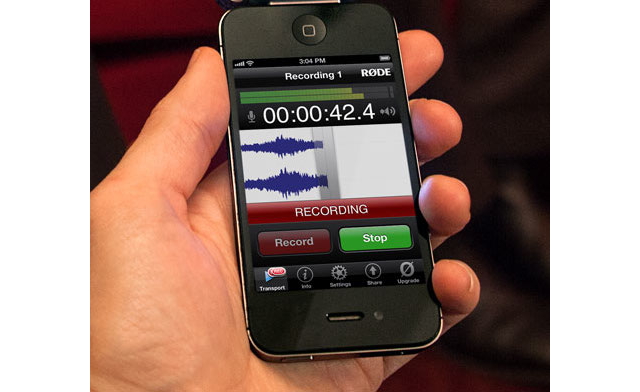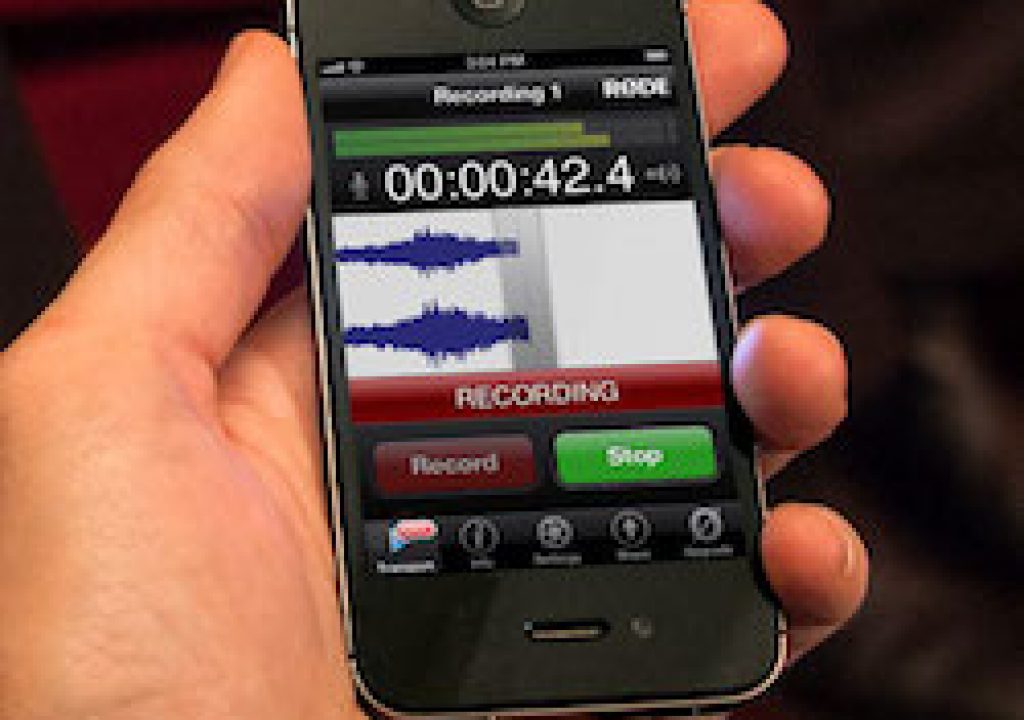
RØDE Rec is the new name of an extremely powerful —yet inexpensive— audio app for iPad/iPhone/iPod Touch I have covered previously, in several articles and ebooks back in 2012, by its original name. The renowned Australian microphone manufacturer (RØDE) actually took the core of the original app and invested a year of custom development to improve it. Ahead we’ll cover the improvements, and point out the only missing details that I’d really like them to add.
RØDE Rec’s past and present
The app that today is known as RØDE Rec was originally called FiRe 2 – Field Recorder and I covered it in my 2012 article called Record audio at 48 kHz on an iPad from a digital source? Yes! and in two of my ebooks. The English-language version one is Hybrid USB/XLR microphones: the missing workflow for independent voice talent & podcasters, and the Castilian-language one is Micrófonos híbridos USB/XLR: el flujo de trabajo faltante para locutores y podifusores independientes. Back then, the app was the only one I could find for recording on iOS that would record 48 kHz audio, which is a must for video, and sometimes also desired for other (audio only) applications. That was way before FiLMiC Pro (an audio/video app) finally added 48 kHz capability later in 2012. But back then, FiRe 2 could record exclusively at 48 kHz, and only in stereo if fed a dual-mono USB audio source. So at that time, I asked the (then) developer to add additional sampling rates and the capability of recording in mono (even from a dual-mono USB source). Now the US$5.99 paid version of the RØDE Rec app fortunately offers several sampling rates, including 44.1 kHz, 48 kHz (a must for audio-for video),
and even 96 kHz, but that last one is only available when using RØDE’s own iXY microphone (shown above). (I clarify the paid version of the RØDE Rec app to differentiate from the RØDE Rec LE free version, which does not offer 48 kHz or many other features available in the paid version, and will nag you perpetually to upgrade to the paid US$5.99 version, which is the one to use.) Fortunately, RØDE Rec now offers the option of recording stereo or mono (even from a USB stereo or dual mono source), and ahead I’ll explain why that’s so important.
Why record mono?
If you are making and audio-only recording from a single mono microphone, there are at least four important advantages to record in mono (monophonic) instead of stereo:
- The audio file will weigh half of what it would have in your own computer or mobile device, which saves space.
- When sending the audio file via Internet, it will weigh half and it will arrive to the destination faster. If you have a data plan that is not unlimited (or they charge you for bandwidth) it's a way of economizing without sacrificing quality. If you are using DropBox or a similar service, it will take half the space.
- Sometimes when people record stereo using some interfaces, it ends up with an empty channel. That empty channel can contain noise and can cause some editing programs to interpret it as stereo. In that case, the operator/editor would have to eliminate that channel manually later (extra work) and might neglect to do so (potentially reducing quality).
- It doesn't matter that the final product may be stereo: the original recording of your voice can —and should— be mono if it comes from a single microphone. During the editing (if esthetically appropriate), your mono voice will end up on both sides (right and left) of the stereophonic image.
Our tests with RØDE Rec with the AT2005USB and Dmitri Michas
Dmitri later discovered how to use RØDE Rec’s trimming adjustments, and really began to love the app, which also includes EQ (equalization), compression, normalization, manual change of gain, high/low-pass filter, frequency cut/boost, live input monitoring, real-time waveform and one-touch markers, non-linear cut/copy/paste/crop, and waveform looping.
Then the unexpected happened: While Dmitri was still in Miami, he received an email request to do an audio audition. I lent him the AT2005USB microphone and the Lighting-to-female USB adapter. Dmitri sat in a closed vehicle, recorded his audition, trimmed it, and sent it out, all from his 5th generation iPod Touch with iOS 7.04. We also determined that RØDE Rec worked fine with iOS 6 on his iPad Mini with the same mic and cable, since Dmitri has specifically been avoiding updating his iPad Mini to iOS 7 due to esthetic preferences on that device.
Other sharing options in RØDE Rec
RØDE Rec can currently output AAC, Apple Lossless, AIFF, MP3, WAV, and FLAC via email, Dropbox, FTP, and SoundCloud.
If you upload an audio clip to SoundCloud, you have the option to allow listeners to download the original file (or not), so (for example) if you upload an uncompressed AIFF or WAVE at 48 kHz mono and choose to allow listeners to download, that original file in that original format will be available for them. However, the SoundCloud streaming file will then be a transcoded MP3 file created automatically by SoundCloud.
So what’s missing from RØDE Rec?
- SFTP: As I have covered in several prior articles, standard FTP unfortunately sends the password as plain text as it travels through the Internet, so a hacker can easily “sniff” the password and later use it to take down (potentially) your entire website (if the FTP is the main one associated with your website).
- Confirmation of encrypted SoundCloud credentials: For the same reason, the credentials used to connect to SoundCloud should also be encrypted. As of publication time, I am still awaiting an answer about this from RØDE. UPDATE: I just jeard from RØDE's marketing manager: “SoundCloud provides its own library for all developers, so we’re not given the choice of authentication. Apparently the SDK indicates that all connection to SoundCloud is via HTTPS.” That is good!
- Option for integration with the iOS Gmail app: Many iOS users have chosen to skip the Apple Mail app in favor of the Gmail app, so RØDE Rec should have that option in its settings. That way, it can use that app to send files instead of calling the Apple Mail app, which (for many users) is not even set up with any accounts. Google provides an API for third-party developers here.
I hope that RØDE will address all of the above soon. However, even in the meantime, I consider RØDE Rec to be well worth the price and I only recommend caution. This may mean setting up a temporary “buffer” FTP, knowing that anything kept there could be compromised; using some SSL/TLS protected account via Apple Mail; or local transfer to your computer via iExplorer or iTunes; or using a VPN.
How to upgrade from FiRe 2 – Field Recorder to the new RØDE Rec app
I asked RØDE public relations what they offer for prior owners of FiRe 2 – Field Recorder who want to upgrade to the new RØDE Rec app. The response was: “We don’t credit FiRe owners. This is partially company policy and partly due to Apple’s limited redemption system where only a small number of free codes are available per release of the app.” So if you previously purchased FiRe 2 -Field Recorder, you should simply go and buy the new RØDE Rec app from Apple’s AppStore. In my opinion, it is well worth the price.
Upcoming articles, reviews, and books
Stand by for upcoming articles, reviews (including RØDE’s PinMic), and books. Sign up to my free mailing list by clicking here.
Si deseas suscribirte a mi lista en castellano, visita aquí. Si prefieres, puedes suscribirte a ambas listas (castellano e inglés).
My latest book (paperback + ebook)
My most recent book is available in two languages, and in paperback as well as an ebook. The ebook format is Kindle, but even if you don’t have a Kindle device, you can read Kindle books on many other devices using a free Kindle app. That includes iPad, Android tablets, Mac computers, and Windows computers. Although generally speaking, Kindle books are readable on smartphones like Androids and iPhones, I don’t recommend it for this particular book since it contains both color photos and color comparison charts. The ebook is also DRM-free.
In English:
In English, it is currently available in the following Amazon stores, depending upon your region:
- Amazon.com, for the US and other countries in the Americas that don’t currently have their own Amazon store, or anywhere if you simply prefer it
- Amazon.br for Brazil
- Amazon.ca for Canada
- Amazon.de for Germany
- Amazon.es for Spain pero a lo mejor lo preferirás en castellano, a continuación)
- Amazon.fr for France
- Amazon.in for India
- Amazon.it for Italy
- Amazon.co.jp for Japan
- Amazon.com.mx for México
- Amazon.co.uk for the United Kingdom
Or in your favorite bookstore by requesting ISBN–10: 1456310232 or ISBN–13: 978–1456310233.
En castellano:
En castellano, está disponible actualmente en las siguientes tiendas Amazon, según tu región:
- Amazon.com para EE.UU. y todas las Américas donde no existe ninguna tienda particular… o en cualquier parte si simplemente lo prefieres
- Amazon.com.br para Brasil
- Amazon.co.jp para Japón
- Amazon.de para Alemania
- Amazon.es para España
- Amazon.fr (Francia)
- Amazon.in para India
- Amazon.it para Italia
- Amazon.com.mx para México
- Amazon.co.uk para el Reino Unido
o en tu librería preferida al solicitar el ISBN–10: 1492783390 ó el ISBN–13: 978–1492783398.
Allan Tépper’s other books, consulting, articles, seminars & audio programs
Contact Allan Tépper for consulting, or find a full listing of his books, articles and upcoming seminars and webinars at AllanTepper.com. Listen to his TecnoTur program, which is now available both in Castilian (aka “Spanish”) and in English, free of charge. Search for TecnoTur in iTunes or visit TecnoTur.us for more information.
FTC disclosure
No manufacturer is specifically paying Allan Tépper or TecnoTur LLC to write this article or the mentioned books. Some of the other manufacturers listed above have contracted Tépper and/or TecnoTur LLC to carry out consulting and/or translations/localizations/transcreations. Many of the manufacturers listed above have sent Allan Tépper review units. So far, none of the manufacturers listed above is/are sponsors of the TecnoTur programs, although they are welcome to do so, and some are, may be (or may have been) sponsors of ProVideo Coalition magazine. Some links to third parties listed in this article and/or on this web page may indirectly benefit TecnoTur LLC via affiliate programs.
Copyright and use of this article
The articles contained in the TecnoTur channel in ProVideo Coalition magazine are copyright Allan Tépper/TecnoTur LLC, except where otherwise attributed. Unauthorized use is prohibited without prior approval, except for short quotes which link back to this page, which are encouraged!

